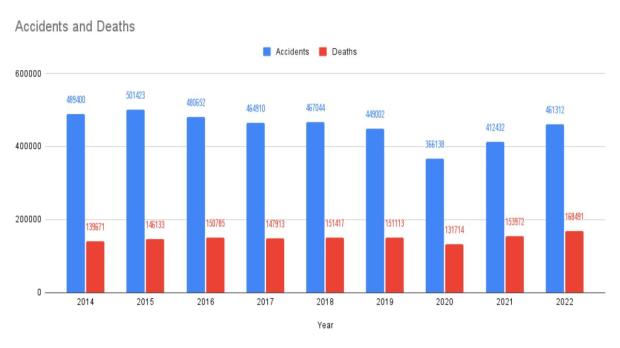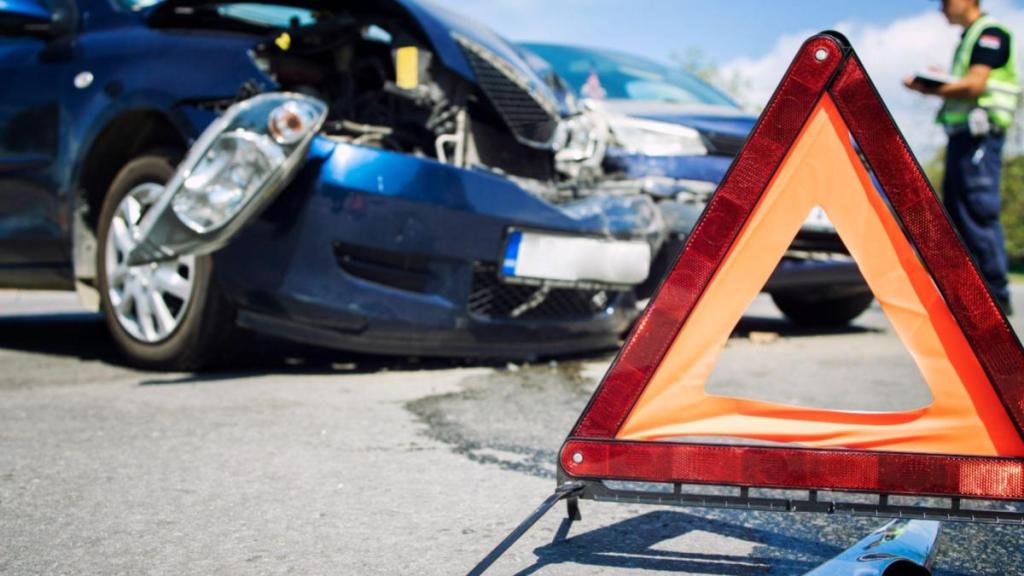India continues to grapple with a dire road safety crisis, with over 15.3 lakh fatalities recorded in road crashes over the past decade (2014-2023). Despite global commitments to reduce road fatalities and interventions by the Supreme Court, the statistics paint a grim picture of insufficient progress. Data from the Union Ministry of Road Transport and Highways sheds light on the severity of India’s road safety issues.
The country reports a road death rate of 250 per 10,000 km, starkly higher than the rates in the United States (57), China (119) and Australia (11). This disparity reflects systemic gaps in enforcement, infrastructure and awareness that continue to plague India’s roads.
Between 2014 and 2023, road fatalities surged by 26.4% compared to the preceding decade (2004-2013), which saw 12.1 lakh deaths. While the increase in population, road length, and vehicle numbers offers some context, experts point out that efforts to curb fatalities remain insufficient. The number of registered vehicles more than doubled from 15.9 crore in 2012 to 38.3 crore in 2024 and road length expanded from 48.6 lakh km in 2012 to 63.3 lakh km in 2019, according to the latest published data.
2023 Road Safety Data: Grim highlights
Union Minister of Road Transport and Highways Nitin Gadkari revealed that 4.80 lakh road accidents occurred in 2023, resulting in 1.72 lakh fatalities, marking a 4.2% increase in accidents and a 2.6% rise in fatalities compared to 2022. Children and young adults have been particularly vulnerable, with 10,000 minors among the deceased.
India averages 1,317 road crashes and 474 fatalities daily, or 55 crashes and 20 deaths every hour, underscoring the critical need for immediate interventions.
Uttar Pradesh recorded the highest number of road fatalities in 2023, with 23,650 deaths resulting from 44,000 accidents. Notably, 1,800 victims were minors, while 10,000 pedestrians and two-wheeler riders lost their lives. Overspeeding accounted for 8,726 deaths in the state, exemplifying the human cost of reckless driving.

Minister Gadkari attributed a significant portion of road crashes to human behavior, emphasizing the lack of respect and adherence to traffic laws. Road design flaws, such as potholes, missing underpasses, and inadequate foot overbridges, exacerbate the problem. Gadkari noted that the ministry has identified over black spots on highways and is investing ₹40,000 crore to rectify them. However, a large portion of state and district roads remains beyond the purview of the National Highways Authority.
The government has directed automobile manufacturers to prioritize safety features in vehicles and improve engineering standards. Concurrently, nationwide awareness campaigns aim to educate citizens on road safety. Gadkari stressed the importance of integrating traffic rules into school curriculums to foster a culture of safety from an early age.
Despite these measures, the minister acknowledged that efforts to reduce accidents by 50% by 2024 have fallen short. “We need to do more work,” Gadkari admitted during a road safety event in Lucknow.
In 2023, road crash severity — the number of fatalities per 100 crashes — declined slightly to 36 from 36.5 in 2022. However, two-wheeler users and pedestrians remain disproportionately affected, accounting for 44.8% and nearly 20% of all fatalities, respectively. These figures underscore the need for targeted interventions to protect vulnerable road users.
Detailed analysis from 2014 to 2022
India’s road accident statistics reflect a concerning trend, with millions of accidents resulting in significant fatalities and injuries over the years. In 2014, the country witnessed approximately 4.89 lakh road accidents, claiming 1.40 lakh lives and injuring more than 4.93 lakh individuals. This translates to an average of 56 accidents and 16 deaths every hour, underscoring the critical need for road safety measures.
Escalation in 2015
The number of road accidents rose by 2.5% in 2015, reaching 5,01,423 cases. Correspondingly, fatalities increased by 4.6%, with 1,46,133 deaths reported. The injury count also grew by 1.4%, amounting to 5,00,279 individuals. Accident severity, measured as deaths per 100 accidents, climbed from 28.5 in 2014 to 29.1 in 2015, signaling heightened risks on Indian roads.
Mixed trends in 2016
In 2016, there were 4,80,652 accidents, a 4.1% decline from the previous year. Injuries also reduced slightly by 1.1%, totaling 4,94,624 cases. However, fatalities continued to rise, increasing by 3.2%, with 1,50,785 deaths recorded. On average, 1,317 accidents and 413 deaths occurred daily, equating to 55 accidents and 17 fatalities every hour. While the reduction in accidents offered some respite, the increase in deaths highlighted the persistent danger.
Declines in 2017
The year 2017 marked the second consecutive annual decrease in road accidents, with 4,64,910 cases reported, down by 3.3 from 2016. Injuries also dropped by 4.8%, with 4,70,975 individuals affected. Encouragingly, fatalities declined for the first time in years, decreasing by 1.9% to 1,47,913 deaths. These reductions indicated progress in addressing road safety challenges.
Marginal increase in 2018
In 2018, the total number of accidents slightly increased to 4,67,044, up by 0.46 compared to 2017. Fatalities saw a sharper rise of 2.4%, reaching 1,51,417 deaths, while injuries decreased marginally by 0.33%, totaling 4,69,418 cases. Accident severity increased by 0.6 percentage points, reflecting ongoing risks despite steady improvements in infrastructure and enforcement.
Notable declines in 2019
Road accidents in 2019 decreased significantly, with 4,49,002 cases, marking a 3.86% decline from the previous year. Fatalities slightly reduced by 0.2%, totaling 1,51,113 deaths, and injuries dropped by 3.86%, affecting 4,51,361 individuals. This consistent reduction in accidents and injuries highlighted incremental progress in road safety initiatives.
Sharp reductions in 2020 amid the pandemic
In 2020, the impact of the COVID-19 pandemic and associated lockdowns led to a substantial drop in road accidents, with 3,66,138 cases, a reduction of 18.46% from 2019. Fatalities decreased by 12.84%, with 1,31,714 deaths, while injuries fell by 22.84%, affecting 3,48,279 individuals. This marked the second consecutive year of decline in both fatal road accidents and overall fatalities. The lockdowns played a significant role in reducing traffic volumes, contributing to the sharp declines.
Accidents and fatalities rise in 2021, 2022
The year 2021 recorded 4,12,432 accidents, resulting in 1,53,972 deaths and 3,84,448 injuries, reflecting a 16.9% surge in fatalities and a 10.39% rise in injuries from 2020.
India witnessed a sharp rise in road accidents and fatalities in 2022, with 4,61,312 accidents reported, a 11.9% increase from 2021. These incidents claimed 1,68,491 lives—a 9.4% rise—and left 4,43,366 injured, marking a 15.3% increase in injuries.
India’s road accident trends reveal a complex scenario. While significant efforts have led to a general decline in accidents and injuries since 2016, occasional spikes in fatalities indicate unresolved challenges. Factors such as speeding, inadequate enforcement of traffic laws, lack of proper road infrastructure and human errors continue to pose threats.


